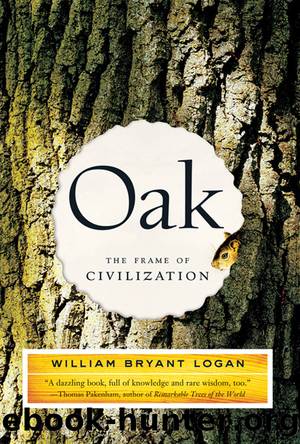Oak by William Bryant Logan

Author:William Bryant Logan
Language: eng
Format: epub
Publisher: W. W. Norton & Company
Published: 2011-11-13T16:00:00+00:00
Mister Tanner
I buy hides and skins and I prepare them by
my craft, and I make of them boots of
various kinds, ankle leathers, shoes,
leather breeches, bottles, bridle-thongs,
flasks and budgets, leather neck-pieces,
spur-leathers, halters, bags and pouches,
and nobody would wish to go through the
winter without my craft.
âa tenth-century shoemaker,
in Aelfric the Grammarian,
Colloquies
Tanners were not known for their subtlety or their refinement. Their job was to take raw animal hides and skinsâoften complete with hoofs, hair, fat, and goreâand convert them into leather. A tannerâs day every day was to pound, scrape, wash, haul, shift, scrub, and stretch wet hides as big as eight feet square and as heavy as bales of hay.
And the work stank. Around the Western world, villages and towns regulated the places where tanners could set up shop, making sure they were not upwind or upstream of any fine residences. The smell of the bloody hides was bad enough, especially as they went rancid, but the tanner would also bag the hair he scraped off, selling the smelly mess to makers of felts, pads, and carpets, or so as to be mixed into plaster. Worst of all, to prepare the hides for tanning, he would soak them in a solution of fermented hen dung.
In spite of all this, the tanner was never ostracized. He was the key member in a chain of âmisteries.â His leather was the basis for what everyone needed: shoes, sandals, boots, leather bottles, and harnesses. No one could work in winter, on hot sands, or on rough ground without him, nor could the animals plow the fields, nor could the soldiers march to war, nor could liquids be carried in quantities too small for barrels. Mr. Shoemaker, Mr. Saddler, and Mr. Butler (the word butler is short for bottle maker), not to mention Mr. Glover and Mr. Bookbinder, needed first the work of Mr. Tanner and his two associates, Mr. Barker and Mr. Currier.
All the leather crafts depended on the tanner, and the tanner depended on the oak. Indeed, the word tan is derived from the Latin for oak bark. When the bark was ground fine and soaked in water with the hides, it released tannins that prevented the skin from rotting and that made it supple and virtually waterproof.
No one knows who first made leather or when, but tanning may be among the most ancient of crafts. Some bone scrapers found at Paleolithic sites are the same shape and size as the two-handed, curved unhairing knives used by tanners tens of millennia later, indeed until the early twentieth century.
The tanning processâlaborious and smellyâwas also complex. The tanners did not know why it worked, but they knew that it did work, and they handed down the methods intact and virtually unchanged from Roman times until the nineteenth century.
It began in the oak groves with the barkers, who went out in spring as the first flush of leaves came on the trees. Sometimes, the tanner barked his own treesâto encourage tanners, some towns granted them rights to
Download
This site does not store any files on its server. We only index and link to content provided by other sites. Please contact the content providers to delete copyright contents if any and email us, we'll remove relevant links or contents immediately.
| Automotive | Engineering |
| Transportation |
Urban Outlaw by Magnus Walker(2946)
Never by Ken Follett(2872)
OPNsense Beginner to Professional by Julio Cesar Bueno de Camargo(2779)
Sapiens and Homo Deus by Yuval Noah Harari(2405)
Machine Learning at Scale with H2O by Gregory Keys | David Whiting(2264)
A Short History of Nearly Everything by Bryson Bill(2131)
Will by Will Smith(2032)
Hooked: A Dark, Contemporary Romance (Never After Series) by Emily McIntire(1932)
Borders by unknow(1779)
Rationality by Steven Pinker(1761)
Holy Bible (NIV) by Zondervan(1711)
Freedom by Sonny Barger(1484)
The One Percenter Encyclopedia by Bill Hayes(1460)
Five Ways to Fall by K.A. Tucker(1394)
Girls Auto Clinic Glove Box Guide by Patrice Banks(1356)
Far and Near by Neil Peart(1352)
The Becoming by Nora Roberts(1323)
Cuba's Car Culture by Tom Cotter(1321)
A Short History of War by Jeremy Black(1295)
